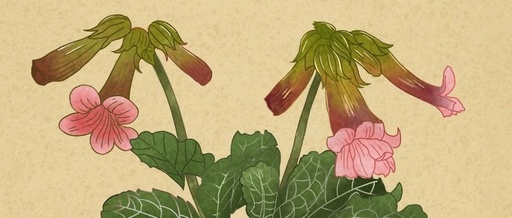↑ Click the above 【Health Preservation Path】 to follow us ↑
Introduction:
Shudi Huang (Rehmannia glutinosa) is commonly used in clinical practice to nourish blood and yin, replenish essence and marrow, and is indicated for blood deficiency, sallow complexion, dizziness, and palpitations. But did you know that Shudi Huang can also treat phlegm and cough?
 Shudi Huang for Treating Phlegm and Cough
Shudi Huang for Treating Phlegm and Cough
Author/Xing Bin
Shudi Huang is a commonly used medicine in clinical practice, but nowadays it is often regarded merely as a general tonic for nourishing blood and yin, and due to concerns about its cloying nature affecting the stomach, it is not frequently used, especially in cough and asthma cases. Many people doubt that Shudi Huang can treat phlegm and cough. In fact, the use of Shudi Huang for cough and asthma has been documented since ancient times, and when applied appropriately, it can yield remarkable results.Usage by Zhang Jingyue
Famous Ming dynasty physician Zhang Jingyue was adept at using Shudi Huang in clinical practice, earning him the nickname “Zhang Shudi.” In his work “Bencao Zheng”, he elaborated on the effects of Shudi Huang, mentioning its ability to treat cough with phlegm due to true yin deficiency. In “Xinfang Bazhen·Buzhen”, it is stated that the Zhenyuan Decoction “treats shortness of breath resembling asthma, rapid breathing, inability to rise, difficulty swallowing, and obstruction of the airways, which can be critical.” This formula consists of Shudi Huang, roasted licorice, and Angelica sinensis, with Shudi Huang being used in larger quantities, typically seven to eight qian, and sometimes up to one or two liang. Jingyue pointed out that this condition appears to be phlegm counterflow and qi stagnation, and that inexperienced physicians might mistakenly use Niu Huang (Bovine Bile), Su He (Liquidambar), Qing Pi (Green Tangerine Peel), Chen Pi (Aged Tangerine Peel), or Zhi Ke (Bitter Orange), while the actual pathology stems from deficiency of the Yuan Sea and depletion of the liver and kidneys, with the key diagnostic feature being a weak, fine pulse lacking spirit, or even a tight pulse.
Another famous formula by Jingyue, Jinshui Liu Jun Decoction, comes from “Xinfang Bazhen·Hezheng” and can be seen as a combination of Zhenyuan Decoction and Erchen Decoction (with one ingredient, Wu Mei, omitted). It is indicated for “lung and kidney deficiency with cold, phlegm due to water retention, or elderly patients with yin deficiency, insufficient blood and qi, and cough with vomiting, excessive phlegm, and wheezing.” Jingyue stated: “When the disease lies between deficiency and excess, it cannot be tonified, nor can it be purged; to achieve balance, it must be treated gently, hence the formula is in the Hezheng category.” Jinshui Liu Jun Decoction employs both tonifying and purging methods, thus fitting into the Hezheng category. Chen Xiuyuan criticized it as a ‘fence-sitting’ formula, which is purely a misunderstanding; I believe it effectively addresses both nourishing yin and transforming phlegm.
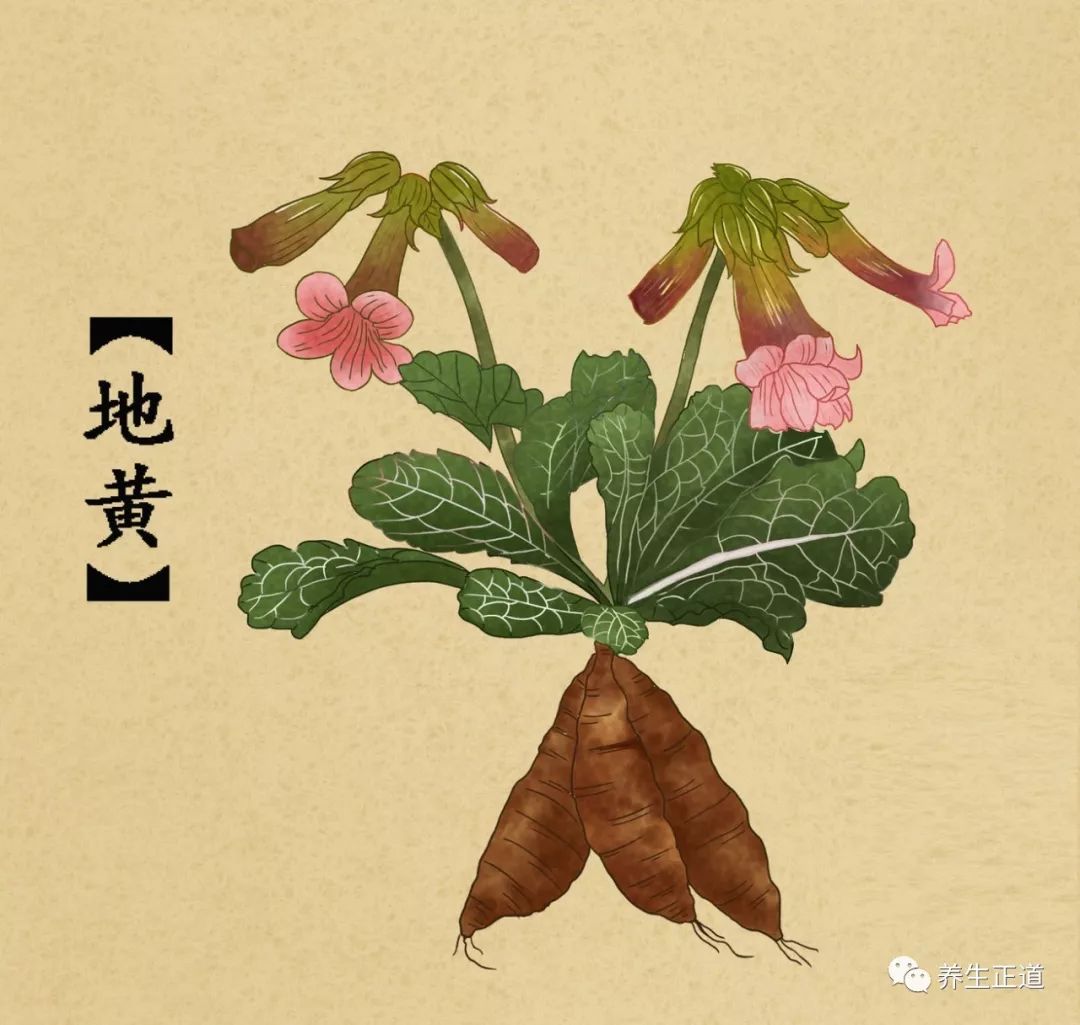
Usage by Ye Tianshi
Qing dynasty physician Ye Tianshi extensively gathered experiences from various schools, and he also applied Zhang Jingyue’s method of using Shudi Huang for cough and asthma. The first case in his “Unpublished Ye Tianshi Medical Cases” is an example. A patient presented with “cough and a rapid pulse,” indicating “deficiency of the organ yin,” and was treated with a combination of Jinshui and Shudi Huang, along with sweet North ginseng, Ophiopogon japonicus, Poria, and Dendrobium. Similar cases can be found in “Clinical Guidelines for Medical Cases,” such as treating a certain individual with “rapid pulse and counterflow cough, requiring the nourishment of kidney yin and softening of metal, employing the method of Jinshui treatment.” The prescription included Shudi Huang (four qian), white hyacinth bean (five qian), North ginseng (three qian), Ophiopogon (two qian), Dendrobium (three qian), and Poria (three qian).
Usage by Wang Mengying
Wang Mengying also frequently used Shudi Huang for treating cough and asthma. For example, “Zhou Guangyuan passed away without illness. His mother, over seventy, suffered this painful loss and gradually developed a cough, with counterflow qi and salty phlegm, often feeling restless at night, with a bitter mouth and lack of appetite. Mengying said: ‘The root is deficient and accompanied by stagnation.’ He prescribed North ginseng, licorice, Ophiopogon, Shudi Huang, turtle shell, Dendrobium, Fritillaria, clam shell, wheat, and jujube for stabilization.” The salty nature of the phlegm was a key diagnostic point.
Another case involved “Gu Xiancha, aged over seventy. In mid-winter, he unexpectedly suffered from phlegm cough, having taken exterior-releasing medicine for several days, with wheezing as if running, unable to lie down, unable to eat, with phlegm wanting to be expelled but unable to do so, feeling the need to move but unable to do so, sitting anxiously day and night, with occasional sweating. His son-in-law asked Mengying to see him, and upon pulse examination, it was weak and large, with a dry red tongue and dripping red urine. The diagnosis was yin deficiency, and he should avoid harsh and dry treatments. He was prescribed Western ginseng, Shudi Huang, Cistanche, goji berries, Semen Trichosanthis, Ophiopogon, Achyranthes, Poria, white peony, Cordyceps, and lead powder in a large dose, boiled with pork to make a clear soup. The phlegm gradually became less viscous, and he was able to sleep and eat comfortably, eventually reporting recovery.” The patient’s advanced age and the inappropriate use of exterior-releasing medicine revealed various signs of true yin deficiency, thus the modified Erli Ointment was used, substituting Western ginseng for ginseng. The phrase “phlegm gradually became less viscous” is also significant, indicating that Shudi Huang and Ophiopogon have the ability to dilute and loosen viscous phlegm, facilitating its expulsion.
Three Cases from the Author
At that time, I had just resigned from the hospital and returned to my alma mater to teach, and was preparing lessons. Frankly, during my university years, I had followed many famous doctors and copied their prescriptions, but I had never seen a teacher use Qingzao Jiufei Decoction. Coincidentally, in March 2008, I encountered a patient like this.
Tai, originally suffering from back pain, had recovered after my treatment. Recently, he had been coughing for nearly two weeks. Initially, he presented with fever, sore throat, and cough, and a chest X-ray indicated lung infection. After treatment, the fever and sore throat were resolved, but the cough persisted. Currently, he had a scratchy throat, cough, no phlegm, poor appetite, a white greasy tongue coating, and a deep pulse. In the first consultation, I used a modified cough-stopping powder, but the medication was ineffective. Having read Professor Zhang’s book, I inquired more carefully about the medical history and learned that he had a scratchy throat and persistent cough, with phlegm that could not be expelled, occasionally producing small amounts of white foamy phlegm. His tongue was purple with a thin white greasy coating, and his pulse was deep and wiry.
I prescribed a modified Qingzao Jiufei Decoction: mulberry leaves 15g, raw gypsum 15g, loquat leaves (wrapped) 9g, donkey-hide gelatin (melted) 9g, North ginseng 15g, Dendrobium 15g, raw and cooked Shudi Huang each 15g, apricot kernel 9g, black sesame 9g, for seven doses. After three doses, the cough lessened, and after five doses, the cough was resolved, and appetite improved.
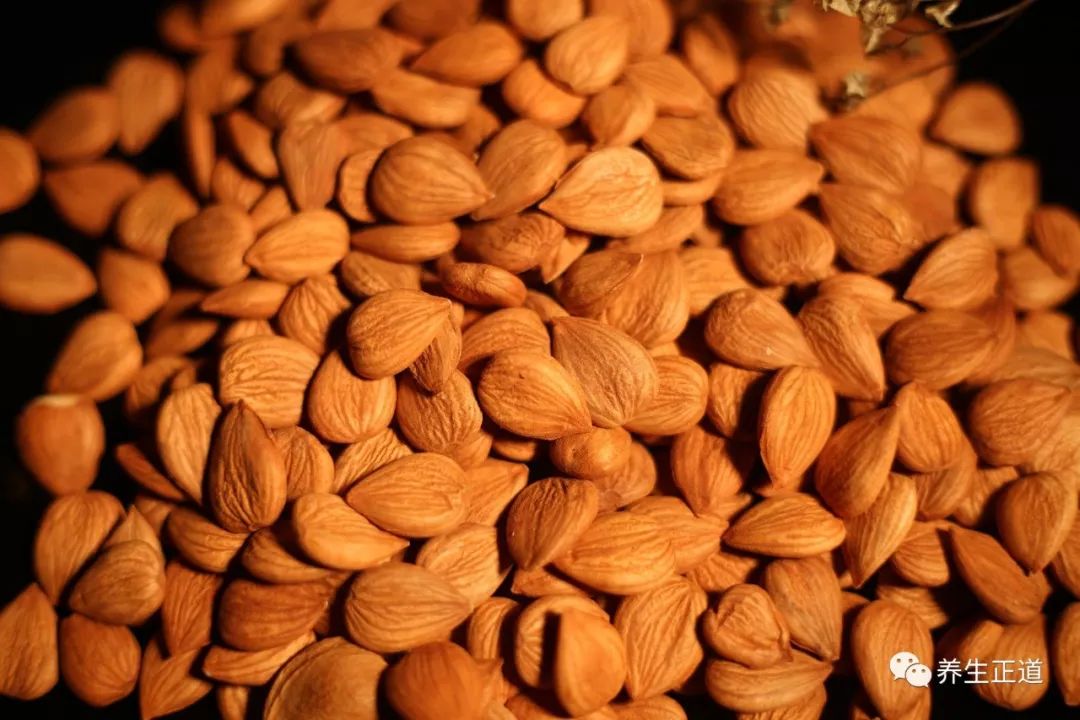
Image: Apricot Kernel
Another case involved Fu, a 77-year-old male. On September 27, 2007, he sought treatment for a cough that had persisted for two months. At that time, he was cured using a method to pacify the liver, clear heat, and benefit the throat, and thereafter, he would come for treatment whenever he had a cough. On March 5, 2009, he came again with a cough lasting three weeks. Initially, he had symptoms of nasal congestion and runny nose, but now the main issue was cough, typically occurring around 7 PM, with a scratchy throat leading to continuous coughing, and the phlegm was sticky and difficult to expel. He would only feel relief after expelling the phlegm, and during severe coughing, it felt as if his breathing would stop. The nature of the phlegm was clear and thin, foamy. No abnormalities were seen on the chest X-ray. In the morning, he woke up with a dry mouth, but usually had a lot of saliva. His tongue coating was slippery, and his pulse was left wiry. The phlegm and cough should be viewed as dry cough, but the excessive saliva and slippery tongue coating also indicated phlegm retention, which was puzzling.
After some hesitation, I prescribed a “fence-sitting” formula: raw ephedra 6g, cinnamon twig 6g, white peony 6g, raw licorice 9g, asarum 9g, dried ginger 3g, prepared pinellia 9g, Shudi Huang 30g, Angelica sinensis 30g, Xuan Shen 60g, Ophiopogon 15g, silkworm 15g, cicada slough 15g, and platycodon 9g, for seven doses. I treated the phlegm retention with Xiao Qinglong Decoction while also using a modified Zhenyuan Decoction to nourish yin and benefit the throat, clearly indicating my mindset was to explore broadly, hoping for a fortunate outcome.
A week later, the family reported that the cough had basically resolved. Upon reflection, the excessive saliva was likely due to a long-standing illness (as I already knew he was a long-term patient), while the cough was a new issue, so at that time, I should have treated the new illness with a modified Zhenyuan Decoction, and once the cough was resolved, I could address the old illness.
On March 26, 2009, I treated a relative, an 84-year-old female with a history of diabetes, who had been coughing for over a month. A chest X-ray indicated bronchial infection, and blood tests showed white blood cells at 11×109/L. She had a scratchy throat leading to continuous coughing, with sticky phlegm that was difficult to expel, and even dry heaving, feeling relief only after expelling white phlegm. Her appetite was normal, but she usually had loose stools. Her tongue was purple with little moisture, and her pulse was thin and wiry. I used the Qingzao Jiufei Decoction method: mulberry leaves 30g, loquat leaves (wrapped) 15g, apricot kernel 9g, Tian Mai Dong each 12g, Shudi Huang 15g, Xuan Shen 30g, gypsum 15g, Zhejiang Fritillaria 15g, fish mint 30g, Scutellaria baicalensis 9g, Wu Mei 9g, silkworm 9g, cicada slough 9g, licorice 6g, for four doses, and the illness was resolved.
Self-Created Xuan Shen Moistening Phlegm Decoction
In the future, I encountered more similar cases, and I increasingly felt that while Qingzao Jiufei Decoction opened a new avenue for treating cough, its formula’s meaning seemed somewhat vague, and the medication lacked specificity and strength. Therefore, I decided to create a more targeted formula with clearer medication principles. I formulated the Xuan Shen Moistening Phlegm Decoction, using Xuan Shen, raw and cooked Shudi Huang, South ginseng, North ginseng, and Angelica sinensis to moisten phlegm and dilute phlegm, creating conditions for phlegm expulsion; using Xuan Shen, Tian Dong, and Mai Dong to moisten phlegm and benefit the throat; using platycodon and licorice to expel phlegm; and if necessary, adding ephedra for its lung-expanding effects, which has shown good efficacy.
Based on previous discussions and my own experiences, I believe the indications for Shudi Huang in cough and asthma cases are:
1. Deficiency of the lower source, where the kidney fails to retain qi, leading to wheezing. This can be treated with Zhenyuan Decoction, adding ginseng, gecko, and Schisandra. Here, Shudi Huang serves as a nourishing true yin and qi-retaining herb, unrelated to phlegm manifestations. It can address dry phlegm, hot phlegm, damp phlegm, or cold phlegm, adjusted according to the syndrome. Zhang Jingyue established Jinshui Liu Jun Decoction, which he said targets lower source deficiency, with external wind-cold, excessive phlegm, and wheezing, indicating kidney deficiency with cold and damp phlegm.
2. Sticky and difficult-to-expel phlegm. This is seen in dry cough and cough with dry phlegm, where Shudi Huang acts as a phlegm-transforming herb, and does not necessarily need to be viewed solely as a nourishing yin herb. The three cases I presented all exemplify this usage.
3. Salty phlegm. Salty phlegm arises from kidney deficiency, and Shudi Huang nourishes the kidney, thus treating it.
The above three points can coexist or not coexist.

Featured Book
“Half a Day in Clinical Practice, Half a Day Reading”
This book chronicles a young physician’s ten years of reading and clinical experiences.
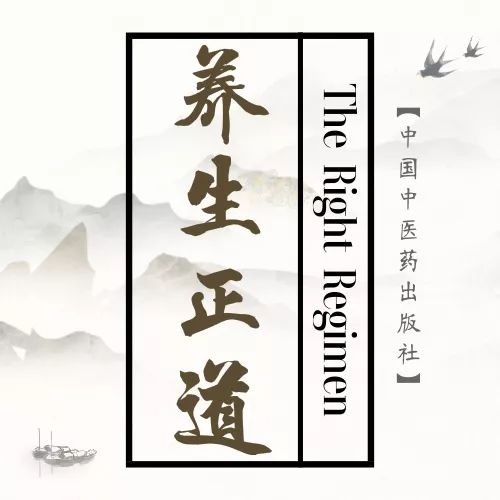
Health Preservation Path
Copyright Statement
This article is excerpted from “Half a Day in Clinical Practice, Half a Day Reading”,Xing Bin◎Author,China Traditional Chinese Medicine Publishing House, copyright belongs to the relevant rights holders.All images are copyright images purchased by the publisher from the image network, please do not steal images.
For commercial cooperation or submissions: [email protected]
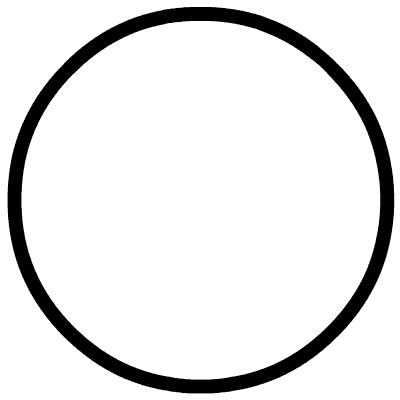 Click “Read the Original” for Discounted Book Purchase
Click “Read the Original” for Discounted Book Purchase

